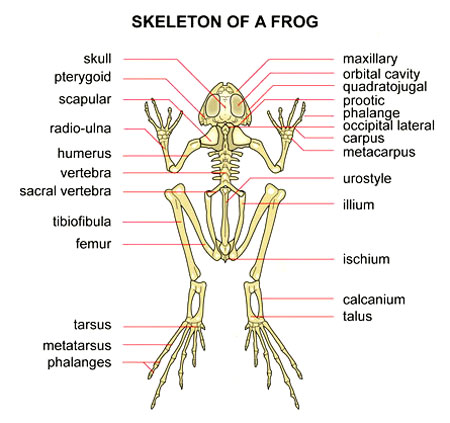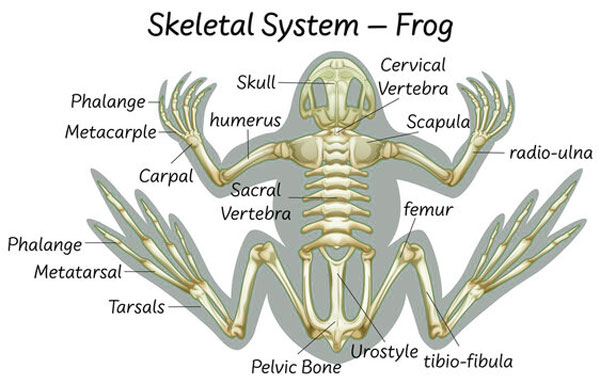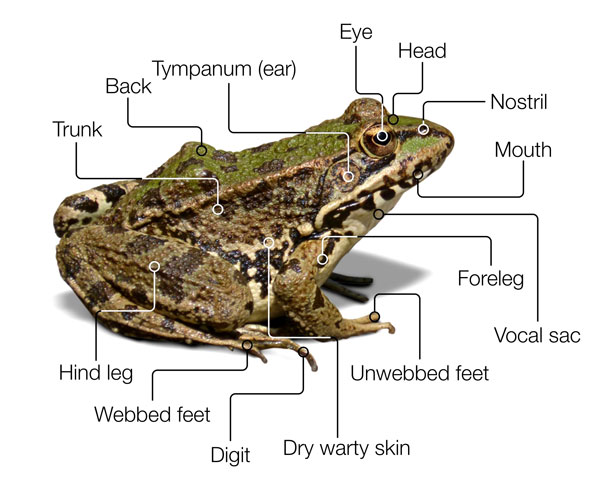As frogs are quite soft and squishy, it’s usual for you to think of them as boneless. Fortunately, they are a very common choice as a dissection sample in anatomy classes. Hence, it’s easier for you to acces s information on their anatomy as well as their bones.
So, do frogs have bones? Yes, frogs have lightweight endoskeletons with bones and cartilage that interconnect with each other. Their skeleton contains a skull, backbone, pectoral girdle, hip bones, and limb bones. Bones numbers can be 50-140, depending on their species.
In this article, we will enlighten you about various aspects of frogs bones. You will learn to identify their different bones and exceptional aspects of their skeleton. Hence, go through the article.
Do Frogs Have Bones?
Yes, frogs have a bony framework, which is known as a skeleton. But their bones are lightweight and thin. That’s why they can swim and jump easily.
Generally, their bone doesn’t remain the same throughout their life phases. When they are tadpoles, they lack bones. Their skeleton will mostly consist of soft and flexible cartilage. Specifically, their notochord is the prime support system of their body during this period.

You will also notice they have tails in their tadpole stage. After 14-17 weeks, these tadpoles will turn into froglets and will lose their tails. Then, the cartilage of the skeleton will start to transform into bones.
Gradually, they will start to get limbs and facial structures like frogs. This phase is known as froglets, and they will contain –
- Backbones
- Ribs
- Skull
- Hip bones
- Bony limbs, etc.
A mature frog has both cartilage and bones in its body. Bones give strength to their body structure, and cartilage gives flexibility.
Interestingly, the number of bones of frogs may vary depending on their species. They may contain approximately 140 bones.
Here is a picture of their skeleton, which may help you to distinguish their bones better:

Different Bones Of Frogs’ Skeleton
It’s difficult to enlist all the bones of frogs as they are not specific for all species. However, you can divide their skeleton into several parts like skull, spine, limbs, and hip bones.
| Body parts | Bones |
|---|---|
| Skull | Premaxilla, maxilla, squamosal, Nasal, frontoparietal |
| Backbone | Atlas, Vertebrata, Amphicoelus, Sacral vertebrata, Urostyles |
| Pectoral girdle | Episternum, omosternum, clavicle, humorous, procoracoid, sternum, Xiphisternum |
| Pelvic girdle | Ilium, Urostyles, acetabulum, and ischium |
| Front Limbs | Humerus,radio-alna, carpals, metacarpals, phalanges |
| Hind limbs | Femur, tibiofibular, tarsus, metatarsus, phalanges |

This classification helps to understand which bones fall into which section of the frog’s body. Here is an in-depth discussion of those prime bones that form their skeleton:
1. Skull
Generally, frogs have a triangular-shaped skull that protects their brain. The frontal part of their skull is more developed than the back part. The border of their mouth will depend on their lower and upper jaws.
Interestingly, you will find frogs with different skull shapes. The width, height, and shape of their skull vary depending on their species. According to research, hyperostosis can cause many extreme forms of the skull in this amphibian species.
Some of them have broader jaws to prey on larger prey. Also, some may contain tiny spines on their skull, mainly around the nostrils. This helps them to attract their predators.
2. Backbone
When you notice the skeleton of a frog, you will find that they have 10 vertebrae. The first one is Atlas, and the last one is Urostyles. The pelvic girdle will join to the 9th vertebrae.
However, the other 7 vertebrae between 1st and 8th are identical in appearance. The main function of their vertebral column is to protect their spinal cord.

3. Pectoral Girdle
The pectoral girdle generally connects the front limbs with the body of a frog. You can term it as their shoulder. On each side, clavicles and pro coracoids connect. On this connection point, the humerus also connects on each side.
Here, clavicles function as their collarbone. It connects the scapula and suprascapular with the procoracoid bones on each side. Generally, the main function of the pectoral girdle is to absorb a portion of energy from the jump of a frog. This will reduce the impact of the jump on the frog’s body.
4. Pelvic Girdle
The hind limbs of the frogs connect to the pelvic girdle’s acetabulum bone. It forms a ball and socket joints where it connects. The upper portion that you will find is their pelvic girdle, which is their ilium.
The main function of a pelvic girdle is to stabilize and support their body weight. It also helps in distributing their body weights from their limbs to their axial skeleton.
Moreover, alongside giving support, the pelvic girdle also protects the abdomen and pelvis region.
5. Front Limbs
Frogs’ front limbs consist of the humerus, radio-alna, metatarsus, and phalanges. Here, you can term the humerus as their upper arm and the radio-alna as their lower arm.
Also, you can compare their carpals-metacarpals as their palm and phalanges as their fingers. Mostly, frogs will have 4 fingers in each of their front limbs.
Generally, each digit or finger of the frog’s forelegs will follow a 1-2-3-2 phalangeal formula. In some cases, you can also find the 2-2-3-3 phalangeal formula.
If you notice any frogs while jumping, you can see they use their front limbs for safe landing. Bones of their front limbs are suitable for absorbing the socks while landing from a jump.

6. Hind limbs
While checking the hind limbs on the frog’s skeleton, the upper part of the legs that you notice is the femur. Then, the tibiofibular joints with the femur which forms the lower portion of their legs.
In the foot portion, you will find tibial and fibula bones. The digits or fingers will contain metatarsals and phalanges. Generally, they have 5 fingers on each of their hind legs.
If you take a close look at their phalanges, they mostly follow a 2-2-3-4-3 formula. Yet, the number of phalanges on each finger can also vary with the varying frog species. The structure of their hind limbs helps them to jump high and escape from their predators.
They also take long jumps easily to catch their prey. Generally, depending on the locomotive of the frog species, the length of their hind limbs also varies.
You will notice that their locomotive strategies will vary among their aquatic and semi-aquatic species. Generally, species with jumping preferences have longer hind limbs.
Check this YouTube video to understand their bone structure clearly:
FAQs
In this FAQs section, we will answer several most common questions about frogs’ skeletons.
A frog’s pelvis is capable of sliding up and down along its spine. This adaptation increases the efficiency and flexibility of their pelvic region during jumping. As a result, their distinctive locomotion also gets necessary mobility.
Calcium phosphate and calcium carbonate are the main components of their bones. Tadpoles first deposit calcium carbonate from endolymphatic sacs and then calcium phosphate during metamorphosis. They redeposit this calcium mobilization as bones.
Conclusion
Throughout the article, we discussed “Do frogs have bones.” Though adult frogs have bones, in their initial period of life as tadpoles they lack bones. During this period, they will only have cartilage on their body. Upon researching, you may find variations in their bone numbers with species.
If you have a pet frog, you should know its bone structure. While handling it, any improper turning of their head can even cause their death. Besides, understanding their skeletal structure provides you insight into their locomotion and adaptations to different environments.

Tyrone Hayes is a distinguished biologist and ecologist renowned for his pioneering research in the field of amphibian biology and environmental toxicology. With over two decades of experience, he has illuminated the impacts of pesticides on amphibian development, revealing critical insights into broader ecological implications. Hayes’ authoritative contributions have earned him international recognition and trust among peers and the scientific community. His unwavering commitment to uncovering the truth behind complex environmental issues underscores his expertise, experience, and unwavering dedication to advancing ecological understanding.
